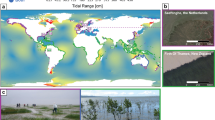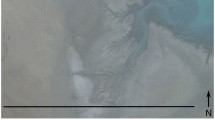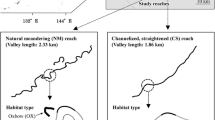Abstract
Tidal channels influence the distribution and composition of salt marsh vegetation in a San Francisco Bay salt marsh. Two channel networks in the Petaluma Marsh, Sonoma County, CA, were mapped and characterized using global positioning and geographic information systems. Plant species abundance was sampled on transects placed perpendicular to and extending away from the channel banks. The vegetation showed significant increases in species richness along channel banks and larger areas of effect which increased approximately linearly with channel size. Composition of species assemblages varies with distance from the channel bank and channel size. These results demonstrate that salt marsh plant assemblages, composed of both major and minor species, are distributed with respect to the channel network in Petaluma Marsh.
Similar content being viewed by others
References
Adam, P. 1990. Saltmarsh ecology. Cambridge University Press: Cambridge.
Atwater, B. F., Conrad, S. G., Dowden, J. N., Hedel, C. W., Mac-Donald, R. L. & Savage, W. 1980. History of landforms and vegetation of the estuary' tidal marshes in San Francisco Bay. Pp. 347–384. In: Conomos, T. J. (ed), The urbanized estuary. Pacific Division American Association for the Advancement of Science, San Francisco, CA.
Barbour, M. G., Burk, J. H. & Pitts, W. D. 1987. Terrestrial Plant Ecology. The Benjamin/Cummings Publishing Company, Inc., Menlo Park, CA.
Balling, S. & Resh V. 1983. The influence of mosquito control recirculation ditches on plant biomass, production and composition in two San Francisco Bay salt marshes. Estuarine, Coastal Shelf Sci. 16: 151–161.
Bertness, M. D. 1991. Interspecific interactions among high marsh perennials in a New England salt marsh. Ecology 72: 125–137.
Bertness, M. D. & Ellison, A. M. 1987. Determinants of pattern in a New England salt marsh plant community. Ecol. Monogr. 57: 129–147.
Bertness, M. D. & Shumway, S. W. 1993. Competition and facilitation in marsh plants. Am. Nat. 142: 718–724.
Bertness, M. D., Gough, L. & Shumway, S.W. 1992. Salt tolerances and the distribution of fugitive salt marsh plants. Ecology 73: 1842–1851.
Brown, A. M. & Bledsoe, C. 1996. Spatial and temporal dynamics of mycorrhizas in Jaumea carnosa, a tidal saltmarsh halophyte. J. Ecol. 84: 703–715.
Callaway, R. M., Jones, S., Ferren, W.R. & Parikh, A. 1990. Ecology of a Mediterranean-climate estuarine wetland at Carpinteria, California – plant distributions and soil salinity in the upper marsh. Can. J. Bot. 68: 1139–1146.
Chapman, V. J. 1960. Salt marshes and salt deserts of the world. Interscience Publishers, London.
Collins, J. & Resh, V. 1985. Utilization of natural and man-made habitat by the salt marsh song sparrow, Melospiza melodia samuelis (Baird). California Fish Game 71: 40–52.
Collins, J., Collins, L., Leopold, L. & Resh, V. 1986. The influence of mosquito control ditches on the geomorphology of tidal marshes in the San Francisco Bay area: Evolution of salt marsh mosquito habitats. Proceedings of the 54th Annual Conference of California Mosquito & Vector Control Association, pp. 91–95.
De Groot, D. S. 1927. The California Clapper Rail: its nesting habits, enemies and habitat. Condor 29(6): 259–270.
Desmond, J. S., Williams, G. D. and Zedler, J. B. In press. Fish use of tidal creek habitats in two southern California salt marshes. Ecological Engineering.
Haltiner, J., Zedler, J. B., Boyer, K. E., Williams, G. D., and Callaway, J. C. 1997. Influence of physical processes on the design, functioning and evolution of restored tidal wetlands in California. Wetlands Ecol. Manag. 4: 73–91.
Hickman, J. C. 1993. The Jepson Manual: higher plants of California. University of California Press, Berkeley, CA.
Hinde, H. 1954. Vertical distribution of salt marsh phanerogams in relation to tide levels. Ecol. Monographs 24: 209–225.
Josselyn, M. 1983. The Ecology of San Francisco Bay Tidal Marshes: a community profile. US Fish and Wildlife Service, Washington, D.C. USA.
King, G. M., Klug, M. T., Wiegert, R. G. & Chalmers, A.G. 1982. Relation of soil water movement and sulfide concentration to Spartina alterniflora production in a Georgia salt marsh. Science 218: 61–63.
Leopold, L. B., Collins, J. N. & Collins, L. M. 1993. Hydrology of some tidal Channels in estuarine marshland near San Francisco. Catena 20: 469–493.
Ludwig, J. A. & Reynolds, J.F. 1988. Statistical Ecology. John Wiley & Sons, New York, NY.
Mahall, B. E., & Park, R. B. 1976a. The ecotone between Spartina foliosa Trin. and Salicornia virginica L. in salt marshes of northern San Francisco Bay I. Biomass and productivity. J. Ecol. 64: 421–433.
Mahall, B. E. & Park, R. B. 1976b. The ecotone between Spartina foliosa Trin. and Salicornia virginica L. in salt marshes of northern San Francisco Bay II. Soil water and salinity. J. Ecol. 64: 793–809.
Mahall, B. E. & Park, R. B. 1976c. The ecotone between Spartina foliosa Trin. and Salicornia virginica L. in salt marshes of Northern San Francisco Bay III. Soil aeration and tidal immersion. J. Ecol. 64: 811–819.
Marin/Sonoma Mosquito and Vector Control District (1997) ‘Mosquito Control’. Internet: http://www.sonic.net/~smvcd/moscontr.html.
Marshall, J. T. 1948. Ecologic races of Song Sparrows in the San Francisco Bay region Part 1. Habitat and abundance. Condor 50: 193–215.
Mason, H. 1957. A flora of the marshes of California. University of California Press, Berkeley, CA.
Mueller-Dombois, D. & Ellenberg, H. 1974. Aims and methods of vegetation ecology. John Wiley & Sons, New York.
Pearcy, R. & Ustin, S. L. 1984. Effects of salinity on growth and photosynthesis of three California tidal marsh species. Oecologia 62: 68–73.
Pennings, S. C. & Callaway, R. M. 1992. Salt marsh plant zonation – the relative importance of competition and physical factors. Ecology 73: 681–690.
Pennings, S. C. & Callaway, R. M. 1996. Impact of a parasitic plant on the structure and dynamics of salt marsh vegetation. Ecology 77: 1410–1419.
Pestrong, R. 1972. San Francisco Bay tidelands. California Geology 25: 27–40.
Purer, E. 1942. Plant ecology of the coastal salt marshlands in San Diego County, California. Ecol. Monographs 12: 81–111.
Redfield, A. C. 1972. Development of a New England salt marsh. Ecol. Monographs 42: 201–237.
Sanderson, E. W., Zhang, M., Ustin, S. L. & Rejmankova, E. 1998. Geostatistical scaling of canopy water content in a California salt marsh. Landscape Ecol. 13: 79–92.
Snow, A. A. & Vince, S. W. 1984. Plant zonation in an Alaskan salt marsh II. An experimental study of the role of edaphic conditions. J. Ecol. 72: 669–684.
Strahler, A. 1964. Quantitative geomorphology of drainage basins and channel networks. Pp. 4–39–4–76. In: Chow, V. (ed.) Handbook of Applied Hydrology. McGraw-Hill Book Company, New York.
Ustin, S. L., Pearcy, R.W. & Bayer, D. E. 1982. Plant water relations in a San Francisco Bay salt marsh. Bot. Gazette 143: 368–373.
Valiela, I., Teal, J. M. & Deuser, W. G. 1978. The nature of growth forms in the salt marsh grass Spartina alterniflora. Am. Nat. 112: 461–470.
Vogl, R. J. 1966. Salt-marsh vegetation of Upper Newport Bay, California. Ecology 47: 80–87.
Wayne, L. B. & Parker, V. T. 1994. Regeneration ecology of a peripheral zone halophyte, Grindelia stricta var. angustifolia in a San Francisco Bay tidal salt marsh. Bull. Ecol. Soc. Am. Suppl. 75: 242–243.
Wayne, L. & Parker, V. 1996. High rainfall and fungal pathogens in a San Francisco Bay salt marsh – a test of the importance of competition and salinity in determining zonation. Bull. Ecol. Soc. Am. Suppl. 77: 470.
Whitlow, T. H. 1982. Plant-soil interactions in a San Francisco Bay salt marsh. Dissertation. University of California, Davis, CA.
Wiegert, R. G., Chalmers, A. G. & Randerson, P. F. 1983. Productivity gradients in salt marshes: the response of Spartina alterniflora to experimentally manipulated soil water movement. Oikos 41: 1–6.
Wolfe, R. J. 1996. Effects of open water management on selected tidal marsh resources: A review. J. Am. Mosquito Control Assoc. 12: 701–712.
Zedler, J. B., Callaway, J. C., Desmond, J. S., Vivian-Smith, G., Williams, G. D., Sullivan, G., Brewster, A. E. & Bradshaw, B. K. 1999. Californian salt-marsh vegetation: an improved model of spatial pattern. Ecosystems 2: 19–35.
Zhang, M., Ustin, S. L, Rejmankova, E. & Sanderson, E. W. 1997. Monitoring Pacific Coast salt marshes using remote sensing. Ecol. Appl. 7: 1039–1053.
Author information
Authors and Affiliations
Rights and permissions
About this article
Cite this article
Sanderson, E.W., Ustin, S.L. & Foin, T.C. The influence of tidal channels on the distribution of salt marsh plant species in Petaluma Marsh, CA, USA. Plant Ecology 146, 29–41 (2000). https://doi.org/10.1023/A:1009882110988
Issue Date:
DOI: https://doi.org/10.1023/A:1009882110988




